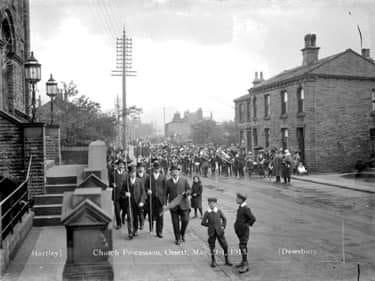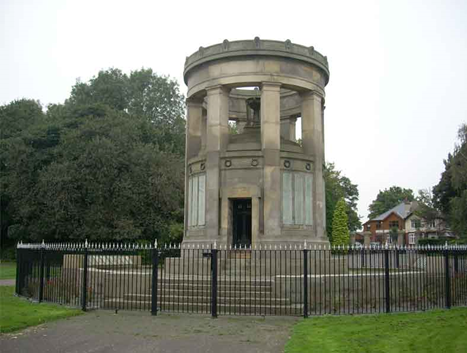
George Glew was born in Earlsheaton in early 1892 the eldest child of eight born to Thomas Henry Glew and his wife Agnes (nee Exley) who married at St. Peter’s Church Earlsheaton on 25th December 1889.
In 1891 the couple were living on Elwood Street, Earlsheaton with Thomas’s parents and siblings. By 1900 the couple had moved to Dale Street Ossett with their three children and a fourth child, Fred, born in Ossett in 1900. The family with seven surviving children was complete by 1911 and had moved to Dewsbury in about 1904. They lived at 24, Boundary Road, Dewsbury Moor where George, aged 19, educated at Christ Church Day School, took work as a piecener in a blanket mill.
 Church Procession on Dale Street, Ossett 1913
Church Procession on Dale Street, Ossett 1913
On 14th July 1913 George Glew, by this time a spinner, married Gladys Parlar at Holy Trinity Church Batley Carr where the couple lived at Carlisle Street. A daughter, Edith, their only child, was born to the couple later that year.
A year later on 4th August 1914 Great Britain declared war on the German Empire and at a stroke millions of lives were changed. George’s army service record has not survived but it is known that he enlisted at Dewsbury and went overseas, embarking at Folkstone and disembarking at Boulogne, as Private 11745 on 21st May 1915 with the 6th (Service) battalion, King’s Own Yorkshire Light Infantry (KOYLI).
The 6th battalion KOYLI was formed at Pontefract on 12th August 1914 and came under the command of the 43rd Brigade in the 14th (Light) Division. It moved initially to Inkerman Barracks Woking, on to Witley in November 1914 and to Aldershot in February 1915. His presence in France as early as May 1915 suggests that George voluntarily enlisted in August 1914 shortly after war was declared.
Whilst George Glew’s army service record has not survived, William Henry, his younger brother’s “Proceedings to Discharge” record remains intact. It is likely that the two brothers enlisted at Dewsbury and joined the King’s Own Yorkshire Light Infantry Regiment on 10th August 1916. Both were appointed to the 6th battalion KOYLI but whereas George continued his training at Witley and Aldershot, William Henry got no further than Witley where it was discovered that he had a “heart strain” sufficiently damaged as to cause his discharge from the Army on 27th November 1914. William Henry Glew died in summer 1965.
We have heard that the 6th battalion KOYLI took command from the 14th (Light) Division which was initially without equipment or arms of any kind. Nonetheless the recruits were judged to be ready by 21st May 1915, although its move to the fighting front was delayed by lack of rifle and artillery ammunition. The Division headed for Belgium and were near Ypres by the end of the month. The following months saw encounters in the Action at Hooge, part of the first flamethrower attack by the Germans, and this was followed by the second attack on Bellewaarde; both near Ypres. Day after day and month after month saw intense shelling as the enemy and the allied forces took turns. Little progress was made by either but many men were killed.

German flame throwers in action on the Western Front.
Image Q41844 by official German photographer, courtesy of the Imperial War Museum.
Private George Glew died in action on 19th September 1915. For much of the month there were heavy bombardments and on this day the British opened on the enemy at 4.50 a.m. Unusually the Regimental War Diary emphasised that the rounds fell increasingly short of the enemy lines and in some parts of our line “shrapnel from our own guns rained rapidly on our own trenches”. There are reports of men being buried in our trenches by high explosives “from behind”, pieces of shell were collected from the trenches which had “undoubtedly come from our own guns…if not from the heavier howitzers…… a dud fell directly behind and its bearing was taken by the artillery officers” Two men were buried and one dead and another two men were wounded, “one being severely wounded”.
That was the setting for the day of Private George Glew’s death on 19th September 1915. He was severely wounded and lost both legs in the bombardment and, in spite of being transported to hospital, he died at the 43rd Field Ambulance Station at Ypres. An eye-witness account of his death was given in a letter to George’s wife and published in the Dewsbury Reporter on 25th September 1915.
George Glew was posthumously awarded the British and Victory Medals for his service overseas in a theatre of war and the 1914-15 Star medal for service on or before 31st December 1915.
He is remembered with honour by the Commonwealth War Graves Commission at Ypres Reservoir Cemetery at IX. E. 24. From April 1915, Ypres was bombarded and destroyed more completely than any other town of its size on the Western Front, but even so certain buildings remained distinguishable. The ruins of the cathedral and the cloth hall stood together in the middle of the city, part of the infantry barracks stood in an angle of the south walls and the prison, reservoir and water tower were together at the western gate. Three cemeteries were made near the western gate: two between the prison and the reservoir. The third is now called Ypres Reservoir Cemetery begun in October 1915 and used by fighting units and field ambulances until after the Armistice, when it contained 1,099 graves. There are now 2,613 Commonwealth servicemen of the First World War buried or commemorated in the cemetery. 1,034 of the burials are unidentified.
Private George Glew is also commemorated at the Dewsbury Cenotaph in Crow Nest Park and in the Dewsbury Roll of Honour kept in Dewsbury Central Library.
 Dewsbury Cenotaph in Crow Nest Park
Dewsbury Cenotaph in Crow Nest Park
In 2022 George Glew, once of Ossett, will be remembered at the Ossett War Memorial in the Market Place where his name will be inscribed alongside his brothers and sisters in arms; the Ossett Fallen.
Research by the Ossett Fallen Team. February 2022.
Sources
Thanks to Dewsbury Sacrifices for their research and support.